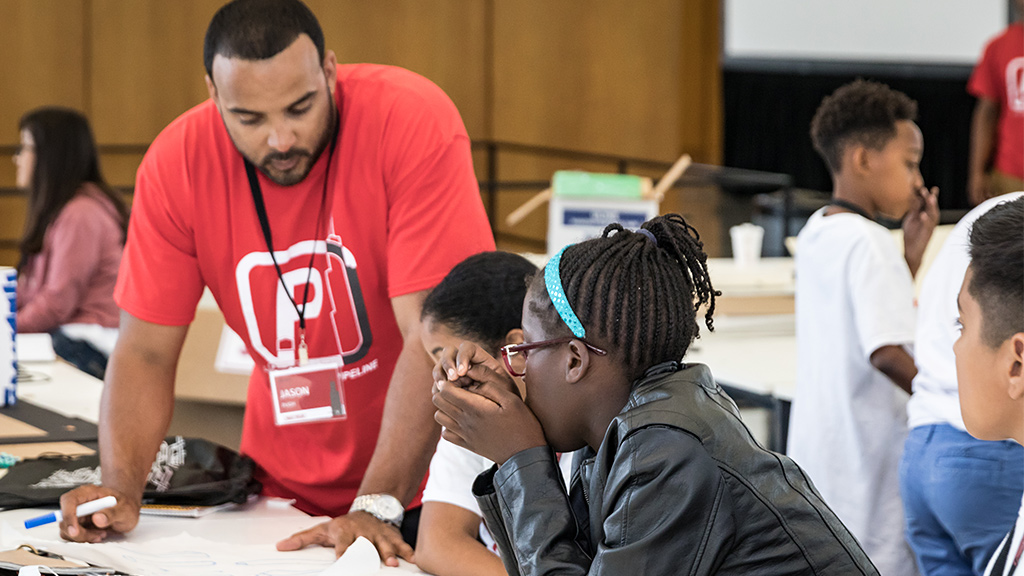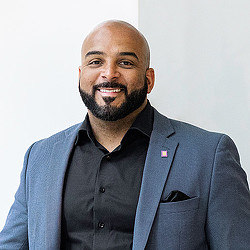7 Questions About Equity and the Design Profession for the Incoming President of NOMA
July 01, 2020 | Jason Pugh, interviewed by Brenden Jackson
America’s current moment of reckoning on race has made it clear that each industry faces its own challenges to achieving justice, equity, and inclusion. Within architecture and design, for example, we find ourselves asking how we can increase the numbers of Black and Brown people among our ranks, engage communities of color in the design process, and advocate for more accessible cities. To explore these and other aspects of equity in our industry, we sat down with Jason Pugh, the president-elect of the National Organization of Minority Architects (NOMA) and a practitioner in Gensler’s Chicago office.
Brenden Jackson: The recent events led NOMA to accelerate the development of a new mission statement that had been in the works for some time. What are the keys to now executing that reframed mission?
Jason Pugh: NOMA’s mission, rooted in a rich legacy of activism, is to empower our local chapters and membership to foster justice and equity in communities of color through outreach, community advocacy, professional development, and design excellence.
In truth, the refinement of the NOMA Mission statement, which hasn’t been updated since 2010, was well in the works by national leadership immediately following NOMA’s Q2 Executive Board meeting in mid-April. With the recent murders of Ahmaud Arbery, Breonna Taylor, and George Floyd, and the responsive civil protest and riots across the country, NOMA believed it was critically important to expedite the public release of the new mission statement in support of our valued members and the communities to which we all serve.
BJ: What are some measures that the design industry can take to increase the level of diversity among our ranks and, specifically, bring more black voices to the table?
JP: The design industry needs to do a much better job of measuring the recruitment, retention, and advancements of minority architects. We’ve all done a horrible job of tracking the numbers of minority students as they graduate, join the industry workforce, and advance in their careers. We barely know the accurate number of licensed Black and Latino architects in the U.S., let alone the total number of minorities practicing architecture (and in rare cases, those serving as Principals or Executives at firms). If you don’t know where you are, you can’t determine where you’re going.
So, a solid start would be documenting these numbers across the board and possibly even making them public. That would allow us to accurately cross-reference and measure growth in the next 5 to 10 years to confirm if we’re collectively making real progress towards our goals.
Once we establish a baseline, then we can establish real measurable goals followed by real action strategies and partnerships at all levels to achieve them.
This can come in the form of meaningful Memorandum of Understanding (MOU) partnerships across industry organizations like NOMA, AIA, NCARB, ACSA, NAAB, etc.
We can also dedicate resources towards K-12 programs like the ACE Mentor Program and NOMA’s Project Pipeline Architecture Camp, which focuses on introducing minority students to career opportunities in the field of architecture and design.
The design industry can do a better job of promoting the scholarships, resources, and endowments for the six HBCU’s (Historically Black Colleges and Universities), which still have Schools of Architecture — I’m a proud graduate of Howard University’s architecture school.
Last but not least, as we’ve tracked the next generation along the way, incentivized programs to follow through and support young professionals as they enter the workforce and ensure they make it through that last arduous leg of the race to complete their Intern Development Program/Architectural Experience Program (IDP/AXP) hours and pass the Architect Registration Examination (ARE) to become licensed.
BJ: What kinds of design and planning projects can make a difference in our cities?
JP: That’s easy… Transportation and Housing.
Sure, the options are overwhelmingly long when you start to examine the laundry list of resources, necessities, and infrastructure missing in marginalized communities, but at the top of the list is accessible public transit and high-quality affordable housing.
One doesn’t have to go very far or be technically trained to see the disparities across the country when it comes to these two viable programmatic components. The comparisons are jarring and in plain sight.
Take a quick look at Chicago’s CTA map, for example. If you graphically note the routes of the train lines, the number of stops, the distance between stops, and the voids and pockets where the CTA is inaccessible for miles, you’ll see what I’m talking about. While the north and northwest portions of the city have multiple routes with stops, some spaced every quarter mile, and all of which connect back to the city, you’ll see the exact opposite on the west and south side of Chicago where predominantly Black and Latino communities reside. There, easy access to public transportation is much more of a challenge. Combine this with limited bus service hours and routes throughout these same communities — in particular during the evenings or weekends — and what you have is an hour-long commute into downtown instead of what should be a 15 to 20-minute commute.
As it relates to quality housing, the pandemic has revealed firsthand the negative impacts of poor conditioned housing. While COVID-19 continues to threaten the entire country, it is hitting certain populations much harder than others — in particular, Black and Latino populations. African Americans currently account for approximately 72% of virus-related fatalities here in Chicago, even though we only make up a little less than a third of the city’s population.
The equities in design most certainly play a role in the transmission, and the abundance of overcrowded housing in low-income neighborhoods is contributing to the spread of the disease. A stronger focus on providing affordable quality housing — along with holistic urban design principles to these communities — would be a start.
Over the last few years, the Gensler Chicago office and Cities and Urban Design team, led by Andre Brumfield, has made strong inroads towards working with community stakeholders, residents, and developers to deliver multiple community master plans with public housing programs all across the country.
BJ: What are some ways to build more participatory decision making into the design process to ensure that communities of color have a say in the development of cities?
JP: It starts with impressing true ownership, authority, and accountability for community residents, stakeholders, and developers equally across the board. Understandably this is difficult given the standard contractual arrangements of our design services tethered to the power and capital of our clients on the majority of our projects. And yet, it’s critically important.
We must level the playing field and recognize the depth of knowledge and untapped resources in the communities we serve by creating influential roles and opportunities for residents to take part in the full design and project delivery process, start to finish.
One example that’s rather unique are newly structured “working groups” here in Chicago. These groups are required for all future developments that are planned on former public housing sites controlled by the Chicago Housing Authority.
Within these working groups, you have the standard client/owner, developer, and architect, and they’ve expanded the team to include the local alderman and public housing residents with supportive legal representation.
The full team meets regularly throughout the design process of the project, and regular updates are shared via forums and townhall sessions that are open to the general public. The residents who serve within this role are compensated fairly, and they have an equal voice and sway during the development of the project. Action teams are deployed when necessary to ensure accountability, and the community’s needs and concerns are brought to the forefront.
By no means is this process perfect, and there is clear room for improvement, but it’s better than most surface-level community engagement plans I’ve seen on the majority of new developments.
BJ: It’s estimated that just 5% of architecture students are black. How can we increase that percentage?
JP: The best way to increase the number of Black architecture students is to engage them early, well before they enter high school. Ideally, we’re talking to kids in grades 6-8, and we’re introducing the wide range of career opportunities within the building and design industry. Investment, promotion, and joint partnership across programs like Project Pipeline and the ACE Mentor Program are excellent ways to connect with bright students and lead them toward promising careers in the profession.
Project Pipeline is a national NOMA initiative that’s focused on inspiring the next generation of architects, planners, and activists. It’s doing that through a series of introductory single-day workshops in classrooms all across the U.S., as well as through various architectural summer camps that expose young students to the concept of scale. Campers take a close look at various typologies from the micro to the macro, and they create models. They start by designing a single-family home before transitioning to community amenity spaces (i.e. grocery stores, recreation centers, fire stations, etc.) and ultimately a skyscraper. On the last day of camp, students collect the models they’ve created over the last few days and incorporate urban planning concepts as they construct a small city.
The ACE Mentor Program is another great afterschool program designed to attract high school students into pursuing careers in the Architecture, Construction, and Engineering industry. Students in the program are introduced to various design professions and the important roles each performs in planning, designing, and constructing a project.
They gain first-hand insight into the design industry by working in various offices and by visiting active construction sites. They also get to work closely with their mentors to solve challenging "real world" projects.
At the end of the year ACE awards the top students with coveted summer internships at partnering firms like Gensler, summer design-build workshops, and much needed college scholarships.
BJ: How can designers best advocate for policies aimed at the development of a just and accessible public realm?
JP: Full support and advocacy for general common policies like aging in place, reduced or frozen property taxes for existing residents, fair and mixed-income housing, stabilized vouchers, and reformed Area Mean Income (AMI) is an easy start.
Expanding traditional design teams to include economic strategists, community outreach specialists, and governing entities is another strategy that lends more weight and support for these policies as well.
With unified support from a deep and diverse team, large developments and community master plan projects can help stabilize and position marginalized communities to benefit from focused economic development opportunities that connect residents with local established and emerging businesses.
Far too often, after the architectural and planning team is gone, clients and residents in these communities are left holding a beautiful master plan document with no clear direction on the next steps or an implementation strategy. The formation of steering committees and community-led action teams is intended to hold developers and policymakers accountable well beyond the completion of major projects and large master plan developments.
BJ: What have you seen or experienced recently that gives you hope?
JP: The collective action, BLM protests and demonstrations, and outreach across the board the last four weeks has left me hopeful. We’ve seen more focused coverage and support on social media and news media outlets, and for the first time in a long time, we’re seeing vocal stances on policy change.
I’m amazed at the overall reach and diversity of the protestors in the streets, black and white, which is unlike anything I’ve ever seen in my lifetime. And honestly, the public stance and tall-order initiatives outlined by large corporations and global firms like Gensler to combat systemic racism and long-standing constructs of imbalanced power and inequity within our industry and the world in general leave me very hopeful that real change is near.
For media inquiries, email .

